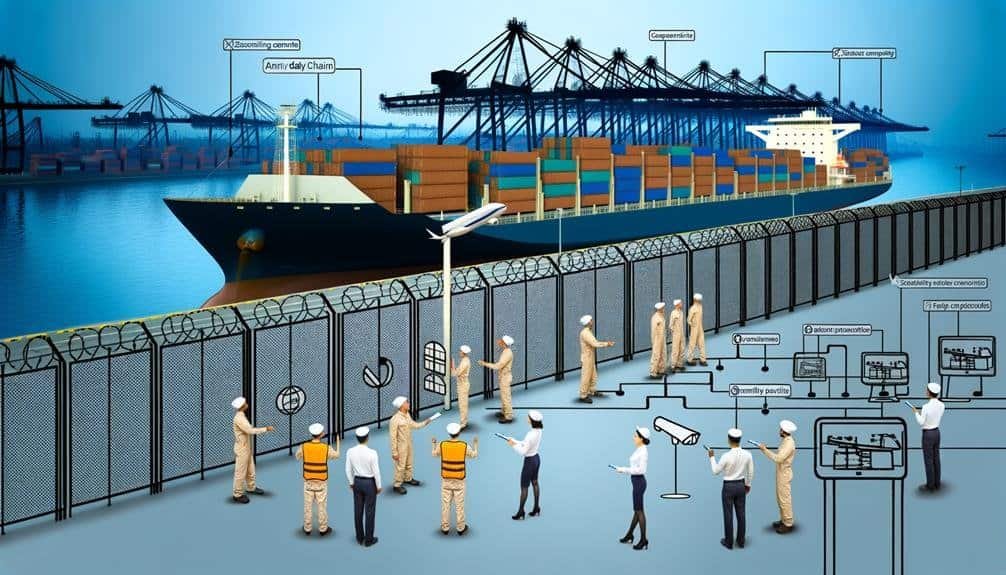What Is CTPAT Compliance?
Imagine a world where your supply chain is as secure as Fort Knox. Where every link in the chain is carefully vetted and monitored to ensure the safety and integrity of your goods.
This is the world of CTPAT compliance. But what exactly is it? How does it work? And why should you care?
In this discussion, we will explore the ins and outs of CTPAT compliance, shedding light on its purpose, benefits, key requirements, and the steps you need to take to achieve and maintain it.
Brace yourself, because the world of supply chain security is about to be unveiled in a way you've never seen before.
Key Takeaways
- CTPAT compliance is crucial for ensuring the security and integrity of international supply chains.
- CTPAT certification offers numerous benefits, including reduced risk, enhanced security practices, and streamlined border crossings.
- Key requirements for CTPAT certification include conducting risk assessments, implementing security programs, and maintaining close relationships with business partners.
- Steps to achieve and maintain CTPAT compliance involve conducting assessments, implementing security measures, training employees, and regularly reviewing and auditing security measures.
The Purpose of CTPAT Compliance
The purpose of CTPAT compliance is to ensure the security and integrity of international supply chains. By implementing and maintaining a strong supply chain security program, businesses can minimize the risk of theft, smuggling, and other security threats.
The importance of supply chain security can't be overstated, as it not only protects the company's assets but also ensures the safety and satisfaction of customers.
CTPAT compliance also brings several benefits to supply chain partnerships. By participating in the program, companies demonstrate their commitment to security, which can enhance their reputation and attract more business opportunities. Additionally, CTPAT compliance allows for faster and more streamlined border crossings, reducing delays and improving overall efficiency in the supply chain.
Benefits of Participating in CTPAT
By participating in CTPAT, businesses can reap a multitude of benefits that enhance their supply chain security and facilitate smoother international trade. Here are four key benefits of participating in CTPAT:
- Reduced risk: CTPAT encourages businesses to conduct thorough risk assessments, helping them identify vulnerabilities in their supply chain and take proactive measures to mitigate potential risks. This can safeguard their operations from disruptions, theft, and other security threats.
- Enhanced security: CTPAT certification demonstrates a commitment to supply chain security, which can boost the confidence of trading partners, customers, and government agencies. It can also lead to improved security practices, such as implementing stricter access controls, enhancing cargo tracking systems, and ensuring the integrity of goods throughout the supply chain.
- Streamlined processes: CTPAT offers various benefits, such as reduced inspections and expedited border crossings, which can significantly reduce shipment delays and save businesses time and money. This streamlined process allows for faster movement of goods, enabling businesses to meet customer demands more efficiently.
- Competitive advantage: CTPAT certification can set businesses apart from their competitors, providing a competitive edge in the global marketplace. It demonstrates a commitment to security and compliance, which can attract new customers and partnerships, as well as open up opportunities for expansion into new markets.
Participating in CTPAT can bring these benefits and more, making it a valuable initiative for businesses looking to enhance their supply chain security and optimize international trade.
Key Requirements for CTPAT Certification
To obtain CTPAT certification, you must fulfill specific requirements that ensure the security and integrity of your supply chain. One key requirement is conducting a comprehensive risk assessment of your supply chain. This involves identifying potential vulnerabilities and implementing measures to mitigate them.
You must also develop and implement a documented and verifiable security program that addresses areas such as physical security, personnel security, and procedural security.
Additionally, you're required to establish and maintain close relationships with your business partners, including suppliers, carriers, and service providers, to ensure their commitment to supply chain security. Regular communication and collaboration are essential to identify and address any security gaps or concerns.
Steps to Achieve and Maintain CTPAT Compliance
Achieving and maintaining CTPAT compliance requires a systematic approach to securing your supply chain. To help you navigate this process, here are four steps to follow:
- Conduct a Risk Assessment:
Identify potential vulnerabilities in your supply chain, including physical security, personnel, and information technology. This step will help you prioritize areas that need improvement.
- Develop and Implement Security Measures:
Based on the results of your risk assessment, create a plan to address any identified vulnerabilities. This may include implementing access controls, conducting background checks on employees, and enhancing data protection protocols.
- Train and Educate Employees:
Ensure that all relevant staff members receive proper training on CTPAT requirements and security procedures. This will help instill a culture of compliance throughout your organization.
- Continuously Monitor and Improve:
Regularly review your security measures and conduct audits to ensure ongoing compliance. Continuous monitoring is crucial to identify and address any potential gaps or risks that may arise.
Conclusion: Ensuring a Secure Supply Chain With CTPAT
After implementing the necessary security measures and training your employees, it's important to continuously monitor and improve your supply chain to ensure ongoing compliance with CTPAT requirements.
Ensuring supply chain security is crucial to protect your business from potential threats and vulnerabilities. By regularly monitoring your supply chain, you can identify any gaps or weaknesses in your security measures and take prompt action to address them. This proactive approach helps to mitigate risks and maintain the integrity of your supply chain.
Additionally, continuous improvement is essential to adapt to evolving security threats and stay ahead of potential disruptions. By staying vigilant and proactive in your efforts to ensure supply chain security, you can build trust with your partners and customers, while also safeguarding your business operations.
Conclusion
You've learned about CTPAT compliance and how it ensures a secure supply chain.
By participating in CTPAT, you can enjoy benefits like increased efficiency and reduced risk.
Remember, meeting the key requirements and following the steps to achieve and maintain CTPAT certification is crucial.
So, stay proactive and keep your supply chain safe with CTPAT.
It's the key that unlocks a fortress of protection for your business.







